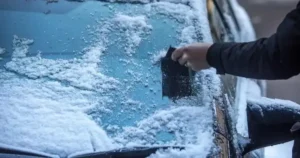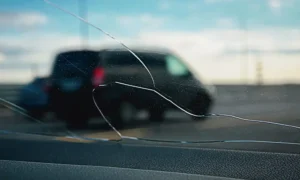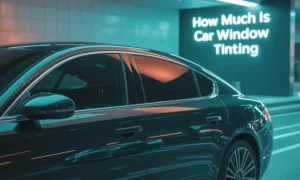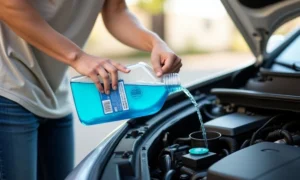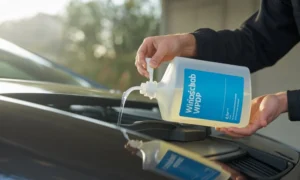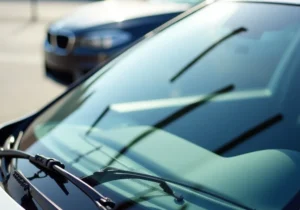Hairline crack in windshield refers to a very thin, narrow fracture on the surface of your car’s windshield. It often starts small—barely noticeable—but can grow over time if left untreated. Unlike chips or deep cracks that result from heavy impact, a hairline windshield crack usually forms due to temperature changes, minor stress, or normal wear and tear. While it may not seem serious at first glance, a hairline crack in windshield can quickly expand, weaken the glass, and compromise your safety on the road. For safety-minded and cost-conscious car owners, understanding the risks and knowing when to act is crucial. Fixing a small crack early often saves you from the higher cost of a full windshield replacement.
Can a Hairline Crack in Windshield Be Repaired?
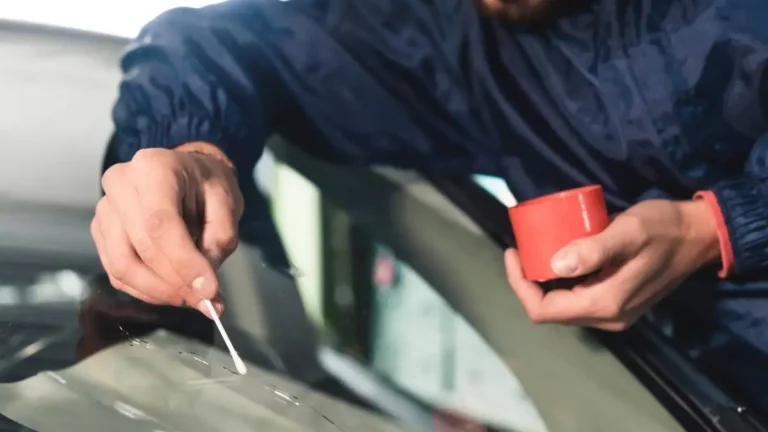
Short answer: Yes, most hairline cracks can be repaired—if treated early.
What Determines If a Hairline Crack Can Be Fixed?
A few crucial elements decide whether a repair is feasible when attempting to fix a little break in a windscreen:
1. Crack Length
Generally, cracks shorter than 6 inches fall within the repairable range. If it’s a hairline crack that hasn’t spread, there’s a strong chance you can avoid replacement.
2. Crack Location
If the windshield hairline crack is directly in the driver’s line of sight, most professionals recommend a full replacement for safety. Also, cracks near the edges can spread quickly, making repairs risky.
3. Crack Depth
A surface-level crack in the top layer of glass can typically be repaired. But if the crack goes deeper into multiple layers of the windshield, repair may not hold up—especially on highways or under pressure from temperature changes.
DIY Kits vs. Professional Windshield Hairline Crack Repair
DIY Kits:
- Inexpensive ($10–$25)
- Work for very small, shallow cracks
- May not last long or seal perfectly
Professional Repair:
- Costs slightly more ($60–$150)
- Ensures the crack is sealed with resin properly
- Backed by warranty in many cases
If you’re unsure, it’s best to let a professional assess the damage first.
Repair vs. Replacement – What’s More Cost-Effective?
- Repair is always cheaper and quicker, especially for a single hairline windshield crack.
- Replacement may cost between $200–$500+, depending on vehicle type, sensors, and glass quality.
The best option? Act quickly to fix hairline crack in windshield before it grows longer or spreads under stress.
Final Advice
Don’t ignore a windshield hairline crack—it can expand with heat, cold, or bumps in the road. For fast and reliable auto glass service in Texas, including crack assessments and full replacements…
Contact Texas Reliable Auto Glass for windshield replacement in Austin today. Let the experts decide whether you need a repair or full replacement—before it’s too late.
Hairline Windshield Cracks: Common Causes
A hairline windshield crack might seem minor, but understanding what causes it can help prevent future damage.
- Thermal Stress: A hairline crack in the windscreen may result from the glass expanding or contracting due to abrupt temperature changes, such as turning on air conditioning on a hot windscreen.
- Road Debris: Small stones or pebbles kicked up by other vehicles can hit the glass, leaving behind a tiny crack that spreads over time.
- Structural Pressure or Poor Installation: Improper windshield fitting or excessive body pressure can create stress points, making the glass more likely to develop cracks.
- Vehicle Vibrations: Constant vibrations or flexing of the vehicle’s frame can slowly trigger a hairline windshield crack.
- Glass Aging: Over time, the windshield becomes more fragile due to exposure and wear, increasing the chances of a hairline crack in the windshield even with minimal impact.
You may read about Can A 12 Inch Crack In Windshield Be Repaired?
The Differences Between Hairline Cracks and Other Kinds of Windscreen Damage
A hairline crack in windshield is much thinner and shorter than most types of auto glass damage. These cracks are often barely visible and may look like a faint line across the surface.
Key Differences:
- Hairline Cracks:
- Thin and shallow
- Usually less than 6 inches
- Often caused by thermal stress or minor impacts
- Can be hard to detect until they spread
- Bullseye Cracks:
- Circular damage with a clear impact point
- Caused by a direct hit (e.g., stone or debris)
- Star Breaks:
- Cracks that branch out from the center
- Look like a starburst pattern
- Edge Cracks:
- Start at the edge of the windshield
- Typically long and more likely to spread quickly
Why Hairline Cracks Still Matter
Despite its tiny appearance, a hairline windscreen crack compromises the glass’s structural integrity. Heat, cold, and vibrations can cause it to spread rapidly.
If ignored, a simple hairline crack in windshield can turn into a major fracture—leading to higher repair costs or full replacement.
Why Should the Windshield's Hairline Crack Be Fixed Right Away?
Fixing a hairline crack in the windshield right away is not just about appearance—it’s about safety, savings, and avoiding long-term problems. A windshield hairline crack repair is a quick and affordable solution that prevents bigger issues down the road.Here’s Why You Should Act Fast:
- Prevents Spreading from Weather or Vibration
Cracks react to heat, cold, and constant vibration. Even a tiny hairline crack in the windshield can quickly spread across the glass from simple things like sun exposure or hitting a pothole. Early repair helps stop this progression. - Avoids Legal Issues and Fines
You risk being pulled over if you drive with a crack in your line of sight. Law enforcement often issues citations for obstructed views. When you fix a hairline crack in windshield early, you stay compliant with safety laws. - Maintains Structural Safety
Your windshield is part of the vehicle’s structural frame. If it’s weakened by a crack—even a small one—it may not perform properly in the event of a crash or airbag deployment. Timely windshield hairline crack repair ensures the glass holds up under stress. - Saves Money in the Long Run
A simple resin repair can cost far less than a full replacement. If you delay, that small crack may require a brand-new windshield, which could cost you several hundred dollars or more depending on your vehicle. - May Affect Insurance Claims
Many auto insurance policies cover small repairs for free or with minimal cost. However, waiting too long might result in denied claims, as insurers could see the damage as negligence. Prompt repair protects your policy benefits.
Don’t wait for that tiny crack to turn into a major headache. If you’re located in or near Austin, contact Texas Reliable Auto Glass for expert repair services and honest pricing. Acting early can save you time, money, and stress.
When to Get Professional Help for a Hairline Crack in Windshield
While some small cracks may seem manageable on your own, certain situations call for expert attention. Knowing when to involve a pro can save you from costly mistakes and ensure your safety on the road.
Call in the Experts If:
- The Crack Is Near the Edge or in the Driver’s Line of Sight
Cracks near the edges are more likely to spread quickly. If it’s blocking your view, it’s a safety risk and could be illegal to drive with. - You See Multiple Small Cracks
If you’re spotting more than one hairline crack in windshield, or if they’re forming a pattern, your windshield may be structurally compromised. - You’re Unsure About the Depth
Not all cracks are surface-level. Deep or layered cracks may seem small on the outside but can grow fast. Let a professional inspect the damage properly. - Your Vehicle Has ADAS Features
Modern cars with Advanced Driver Assistance Systems (lane keep assist, automatic braking, etc.) need proper sensor calibration during and after a repair. DIY won’t cut it in this case.
If you’re in the Austin area, don’t risk it—Texas Reliable Auto Glass offers expert windshield hairline crack repair and replacements with ADAS calibration. Contact us now for fast, affordable, and professional auto glass service in Austin.
FAQs
What Causes Hairline Cracks In Windshields?
Hairline cracks in windshields can be caused by various factors, including road debris impacts, temperature changes, stress from structural flexing, and underlying defects in the glass.
Are Hairline Cracks Dangerous?
While hairline cracks may seem minor, they can compromise the integrity of the windshield, affecting its ability to withstand impact and potentially leading to further damage or even shattering in the event of a collision.
Can I Drive With A Hairline Crack In My Windshield?
It’s generally not recommended to drive with a hairline crack, as it can worsen due to vibration and changes in temperature. Additionally, depending on local regulations, driving with a cracked windshield may be illegal and result in fines.
Can A Hairline Crack In A Windshield Be Repaired?
Yes, hairline cracks in windshields can often be repaired by professional technicians using specialized techniques such as resin injection. Prompt repair is essential to prevent the crack from spreading and to restore the windshield’s strength.
Will A Repaired Hairline Crack Be Visible?
Professional windshield repair techniques aim to minimize the visibility of the repaired crack, but some faint traces may still be visible upon close inspection. However, the repair should not significantly impair visibility while driving.
How Long Does It Take To Repair A Hairline Crack In A Windshield?
The time required to repair a hairline crack in a windshield can vary depending on factors such as the size and location of the crack, the repair technique used, and the technician’s expertise. In many cases, repairs can be completed in under an hour.


